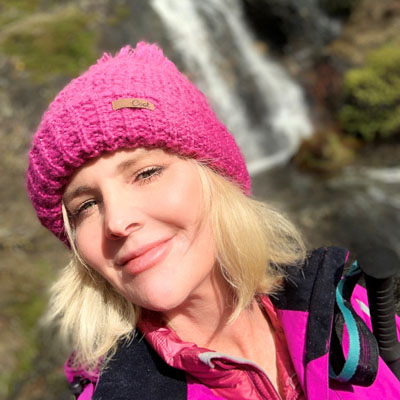
If you like to bike and you are looking for a fun adventure, consider riding the Pittsburgh to DC bike trail!

Pittsburgh to DC Bike Trail: Bikepacking the GAP and C&O Canal Towpath Trails
If you’re looking for a biking adventure that combines history, nature, 100% off-road trail biking, and breathtaking scenery, look no further than the Great Allegheny Passage (GAP) and Chesapeake & Ohio (C&O) Canal Towpath Trail. This 335-mile bike route takes you via trail from Pittsburgh, PA, to Washington, DC, winding through the stunning Appalachian Mountains and offering a glimpse into the region’s rich history.


About the Route:

Along with the amazing beauty and history that dot these two bike trails from Pittsburgh to DC, the best part is that the entire 335 miles are trail riding… i.e., no biking on roads with cars!

It’s also great that the trails are mostly a flat(ish) grade – no more than 1.5% grade (for the most part). The exception to this 1.5% grade is when you climb up and then bike down the Eastern Continental Divide, which fortunately wasn’t too bad in the direction we biked (Pittsburgh to DC).

About the GAP Trail:

Starting in Pittsburgh, the 150-mile Great Allegheny Passage (GAP) trail follows the path of old railways, passing through charming towns and offering stunning views of the surrounding mountains.

As you pedal along the trail, you’ll see remnants of the area’s industrial past, including old train stations and tunnels that have been converted into bike trails.

Big Savage Tunnel:

One of the many highlights of the GAP trail is the Big Savage Tunnel, which spans 3,291 feet and is the 7th longest bike tunnel in the United States. The tunnel was built in 1912 by the Western Maryland Railway, and refurbished in 2003 for bicyclists and hikers.

As you enter the tunnel, you’ll be enveloped in darkness, but soon you’ll see the light at the end of the tunnel and emerge into a beautiful valley surrounded by mountains.

Other personal highlights of the GAP trail include climbing up and crossing over the Eastern Continental Divide. At the time, this feat felt like a big accomplishment with my weighted bike. In reality, it really wasn’t that difficult with the trail’s low grade since the elevation gain spanned over many miles.


Biking through the small towns along the trail and reading the historical placards that dot the trail was also great.


I loved seeing the bike-related art sculptures and the many trains that passed us every day along the way.

The confluence section of the GAP trail was beyond gorgeous. Some day I hope to return to this area and backpack the Laurel Highlands Hiking Trail. This is a beautiful 70-mile backpacking and hiking trail that runs from Ohiopyle State Park across Pennsylvania’s remote Laurel Ridge.

About the C&O Canal Towpath Trail:


From the end of the GAP trail in Cumberland, Maryland, you can pick up the C&O Canal Towpath Trail.

The C&O Canal Towpath Trail follows the path of the historic C&O Canal and runs for 184.5 miles. It takes you through some of the most beautiful and secluded areas of the Appalachian Mountains. There’s even a section of this trail that overlaps with the Appalachian Trail for a bit.


Along the way, you’ll see historic lock houses (these are awesome!), aqueducts, old battleground sites, and other remnants of the canal era. You’ll also pedal through beautiful forests, past rushing streams, and across picturesque bridges.

Paw Paw Tunnel Closure and Detour:

One of the highlights of the C&O Canal Towpath Trail is the Paw Paw Tunnel (currently closed for construction), which is 3,118 feet long and was constructed in 1836. The tunnel is dark and damp and has a nice cool breeze running through it.

Because the Paw Paw tunnel is currently closed for construction, you will have to detour up and over it by pushing your bike for roughly 1.5 miles until you reach the other side of the tunnel. For most bikers, this detour is a dreaded part of the bike-packing adventure. I, however, really enjoyed the challenge of pushing my weighted bike up the mountain (hello type 2 fun). The downhill section after the climb was also really fun to ride, although some bikers may opt to walk and push their bike down this part as well.
About the GAP & C&O Canal Towpath Trails:


As we traveled along this bike trail from Pittsburgh to DC, we encountered beautiful bodies of water, wildflowers, and wildlife. We were lucky enough to spot snakes, groundhogs, fox, blue heron, grouse, deer, eagles, turkeys, chickens, cows, peregrine falcons, cardinals, ospreys, and too many turtles basking on logs to count.


Harpers Ferry:

You’ll also pass through charming towns like Harpers Ferry, West Virginia, where you can break to explore local shops, cafes, and museums.


We took a zero day in Harpers Ferry and really enjoyed hiking up and into the Harpers Ferry National Historical Park. Exploring the history-rich town of Harpers Ferry was definitely a highlight of our bikepacking adventure for me.


Biking the GAP and C&O Canal Towpath Trail from Pittsburgh to DC is a bucket-list bike adventure for many cyclists. The experience will take you back in time through some of the most beautiful and historic parts of the eastern United States. Whether you’re an experienced cyclist or a beginner, this trail offers something for everyone.
Trail Guide:

But before you hit the trail, it’s important to plan ahead for food, lodging, and camping along the way. I highly recommend you pick up the Trail Guide: Travel the Great Allegheny Passage and C&O Canal Towpath. You can order it here… https://gaptrail.org/before-you-go/trailguide/

Here’s a short list of what you need to know to help you navigate the logistics of your trip.
Food:

The towns along the GAP and C&O Canal Towpath Trail offer a variety of dining options, ranging from casual cafes to upscale restaurants. You will also find convenience stores, gas stations, and markets in many of the towns, where you can purchase snacks and other essentials. Most towns on this trail also have bike shops where they often sell bikepacking food, snacks, and cold drinks.

If you’re camping, be sure to pack easy-to-prepare food that doesn’t require much space in your panniers. Although some campsites have grills or fire pits allowing you to cook over an open flame, we used our backpacking stove to prepare our meals, coffee, and tea. Don’t forget to pack a water filter, as there may be stretches without access to potable treated well water.


Lodging

There are a variety of lodging options along the GAP and C&O Canal Towpath Trail, from camping to hotels. We did a combination of both, taking advantage of hotels half the trip (hello shower, toilets with running water, warmth, comfy bed, and laundry facilities) while also enjoying half our nights at picturesque campsites along the way as well. Here are some of the most popular lodging options:

- Camping: There are numerous campsites along the trail, ranging from primitive sites to those with showers and other amenities. Some campsites require a fee, while others are free.
- Hostels and Lock Houses: There are several hostels and lock houses along the trail, which offer affordable lodging for cyclists. Lodging typically includes bunk beds, communal kitchens, and shared bathrooms. Advance reservations are required.
- Bed and breakfasts: There are many bed and breakfast inns in the towns and villages along the trail. These offer a more comfortable, luxurious option for those who don’t want to camp.
- Hotels: Some towns along the trail have hotels or motels for those who prefer more traditional lodging.


It’s important to plan ahead for lodging, especially during peak season when campsites and hostels may fill up quickly. You may need to make reservations in advance.

Camping

If you’re planning on camping along the trail, there are a few things to keep in mind:
- Camping is only allowed in designated campsites along the trail.
- Some campsites require a fee, while others are free. Fees are typically used to maintain the campsites and facilities.
- Some campsites have amenities like showers, water, fire pits, and restrooms, while others are more primitive. None of our campsites had showers, but they all had outhouses or porta potties and a water source on site. Be prepared and carry your own water in the event there is no water source at your campsite.
- I recommend bringing a water filter or purification tablets. The trail hosts many water stations where you can pump well water that may or may not have been treated. I would never drink that well water without filtering it first – even after reading it was “treated.” One water stop left my water filter brown and murky for days, even after I had flushed it out. It didn’t help that the signs cautioned you to drink the treated well water at your own risk. No, thank you.

Leave NO Trace:
It’s important to follow Leave No Trace principles when camping along the trail. This includes packing out all trash and leaving the campsite better than you found it.


MY Pittsburgh to DC Bike Trail Experience:

Our Group Size:
My crew was comprised of six people, all hailing from Northern New Mexico. One couple in our group drove their campervan loaded with all six of our bikes from NM to PA. The remaining four of us flew to Pittsburgh, PA, where we all met up.

Parking and Transportation Logistics:
After unloading the bikes from the campervan in Pittsburgh (near the start of the bike trail), one of our crew (Rod) drove the campervan to my friend’s house in DC (7.5 miles from the end of the trail), where we parked it until we finished with the trail. Rod then took the train back to Pittsburgh to the start of the trail, where we began our biking adventure. It was nice having the campervan waiting for us at the end of our adventure.

Wondering if you need biking experience?
Out of the six of us, I was the only “non-biker” in the group. That’s not to say that the others bike all the time (they don’t), but they had all done bike-packing trips before this one. My longest bike ride before this trip was maybe a whopping 15 miles. Although I didn’t have road biking experience, I did have endurance training on my side from my past marathons, trail running, hiking, mountain biking, and backpacking experiences. Entering this trip, I was nervous that I would hold the others back, but that was never an issue. I was more than equipped to hold my own out there. The mostly flat trail made for an easy and honestly not that challenging biking experience for me.

What Kind of Bike is Best for this Trail?
I was also the only one in our group that brought a mountain bike. The others all had gravel or touring bikes of some sort. I found biking with a mountain bike required more effort, but nowhere or time was it too challenging.

Alan was nice enough to switch bikes with me so I could ride the easier, old touring bike he was riding when I wanted a break from my heavier and bigger mountain bike and tires with more resistance. Truth be told, I probably ended up riding his old touring bike more than my own mountain bike!

I did, however, appreciate my mountain bike tires and suspension on some of the bumpier sections of the trail. As a rule, stick to a tire size of at least 28mm wide – although others may prefer a bigger tire for the bumpier and rocky C&O Canal Towpath trail.

Bikepacking Trip Timing, Weather, and Crowds:

Our bike trail ride adventure began in Pittsburgh on April 16th and finished in DC on April 24th. We took our time biking the 335 miles and took many breaks along the way. During these stops, we took photos, ate in cafes, read the placards on the trail detailing the area’s rich history, and ate snacks while enjoying the scenery.

The trails were mostly empty because we were biking before the official biking season. This meant we had no issues finding accommodation. We also encountered very few bugs this early in the season.

It also meant that we had some huge variances in the weather, unfortunately. We experienced everything from 30-degree nights/mornings with snow and frost to 95-degree temps on the hotter days.

We also encountered our fair share of rain, crazy headwinds, and even lightning at times. It was definitely an adventure, and my bones are still chilled from biking in that merciless cold wind and rain.

Trail Conditions:

Although our trip lasted ten days, because we had a zero-day in Harpers Ferry, we only biked nine days. The trails were easy to navigate. They had plenty of water stations and even some bike maintenance stations along the way. I enjoyed stopping to read the placards describing the local history that lined the path from start to finish. The towns and local businesses were all generally biker-friendly, which was a plus!

The trails are smooth in some places and bumpy and rocky in others. All of our bikes performed fine, and even with the two days of rain, mud was not an issue for us in those spots. I could see how rain would have made the trail too muddy for enjoyable riding in other spots, however. We had one flat between the six of us for the duration of the entire trip.

Daily Mileage and Biking Speed:
Below is a summary of our daily mileage. Our miles equal more than 335 miles because we biked additional miles to and from restaurants, historical sites, and markets on most days. My moving bike speed was usually between 8-12 mph. Our average total bike speed (including both moving time and stops/breaks) averaged roughly 7 mph.
- 37.4 Miles (Pittsburgh, PA) – Day 1
- 45 Miles – Day 2
- 38.4 Miles – Day 3
- 33.2 Miles – Day 4
- 45 Miles – Day 5
- 44.2 Miles – Day 6
- 42.1 Miles – Day 7
- Zero Day in Harpers Ferry – Day 8
- 32.2 Miles – Day 9
- 39 Miles (DC arrival) – Day 10

What to Pack:
Good news, if you already have a bike and backpacking gear, you are mostly there!

Here’s what Alan and I packed for our Pittsburgh to DC bike trail bike-packing adventure:
We Carried:
- 2 panniers (each)
- 2 bike racks (one for each of us) with straps
- Multiple dry bags to keep our stuff dry in wet weather
- backpacking tent for two
- Trail Guide – Great Allegheny Passage C&O Canal Towpath. This very useful guide includes a trail map.
- backpacking sleeping pads (2 total – one for each of us)
- sleeping bags (2 total – one for each of us)
- backpacking pillows (2 total – one for each of us)
- backpacking stove, fuel, pot, bowls, mugs, lighter and spork
- extra bike tubes in case of flat tires
- cable bike lock
- multi-tool, zip ties, and bike pump
- duct tape and rope/cord (didn’t use either of these)
- BeFree water filter
- Ziplock bag to carry out our trash
- bike water bottles (one for each of us)
- 2 headlamps
- helmets
- bike shoes with toe covers
- biking gloves (both a warm and cold weather set)
- camp shoes (Alan flip flops, me lightweight Xero shoes)
- battery pack (Anker) and phone charging cable
- sunscreen
- bug spray and mosquito net
- tweezers, toothbrush & toothpaste, floss, nail clippers, toilet paper, body wipes, tissues, first aid kit, and camp-friendly soap
- Kula cloth and menstrual cup
- sunglasses
- Clothing: layers including rain gear (pants and jacket), puffy jacket, biking shorts, non-biking shorts and tee shirt for town, pants, underwear, socks, base layers, swimsuit, and sun hoodie
- snacks we had in our bags at different points in the trip: dates, nuts, cheese, dried mango, fresh fruit (bananas, oranges, apples), candy bars, backpacking meals, peanut butter, coffee, tea, and oatmeal
- camp towel (could have gone without since we didn’t shower while camping). Alan did jump in the freezing river once or twice, however. :-0
- backpacking sitting pad (could have gone without)
- trigger point foam massage ball (could have gone without)
- sun hat (could have gone without)

In Conclusion:
The Great Allegheny Passage (GAP) and Chesapeake & Ohio (C&O) Canal Towpath Trail offer an unforgettable biking adventure through some of the most beautiful and historic parts of the eastern United States. With a bit of planning and preparation, you can enjoy the trail while ensuring you have enough food, water, lodging, and camping options along the way. This trail is 100% worth it for experienced bikers and newbies alike. I highly recommend you plan your adventure now! Grab your bike, helmet, and your best and most adventurous self, and saddle up!



Other adventure posts similar to the Pittsburgh to DC Bike Trail:
For other adventure ideas, check out my blogs on backpacking the Camino De Santiago pilgrimage in Spain here and the John Muir Trail in California here. See below for a few more photos from our trip!








